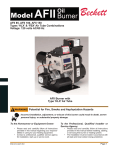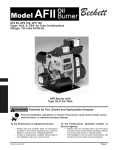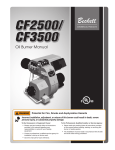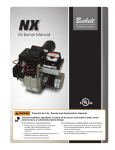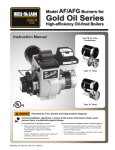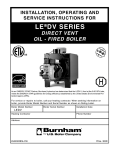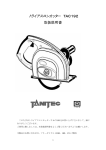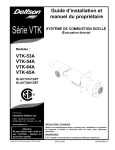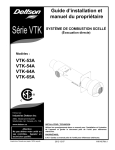Download Beckett AF Instruction manual
Transcript
RESIDENTIAL BURNERS Potential for Fire, Smoke and Asphyxiation Hazards Incorrect installation, adjustment, or misuse of this burner could result in death, severe personal injury, or substantial property damage. To the Homeowner or Equipment Owner: y Please read and carefully follow all instructions provided in this manual regarding your responsibilities in caring for your heating equipment. y Contact a professional, qualified service agency for installation, start-up or service work. y Save this manual for future reference. To the Professional, Qualified Installer or Service Agency: y Please read and carefully follow all instructions provided in this manual before installing, starting, or servicing this burner or heating system. y The Installation must be made in accordance with all state and local codes having jurisdiction. 2 To the Owner: Thank you for purchasing a Beckett burner for use with your heating appliance. Please pay attention to the Safety Warnings contained within this instruction manual. Keep this manual for your records and provide it to your qualified service agency for use in professionally setting up and maintaining your oil burner. Your Beckett burner will provide years of efficient operation if it is professionally installed and maintained by a qualified service technician. If at any time the burner does not appear to be operating properly, immediately contact your qualified service agency for consultation. Contents General Information .................................................... 4 Hazard Definitions ........................................................................ 4 ▼ Remainder of manual to be used ONLY BY QUALIFIED SERVICE TECHNICIANS ▼ Inspect/Prepare Installation Site ................................ 5 Clearances to Burner and Appliance............................................. 5 Combustion Chamber and Burner Retrofitting .............................. 5 Inspect Chimney or Direct Vent System........................................ 5 Combustion Air Supply Information ............................................... 7 Direct/Sidewall Venting Application .............................................. 7 Prepare the Burner ...................................................... 8 General ......................................................................................... 8 Installing the Oil Tank and Supply System .................................... 8 Fuel Line Valves and Filter ........................................................... 8 Mount Burner on Appliance ........................................................... 9 Connect Fuel Lines ....................................................................... 9 We recommend annual inspection/ service of your oil heating system by a qualified service agency. Wire Burner .................................................................. 9 Daily – Check the room in which your burner/appliance is installed. Make sure: Burner Controls ......................................................... 10 y Air ventilation openings are clean and unobstructed y Nothing is blocking burner inlet air openings y No combustible materials are stored near the heating appliance y There are no signs of oil or water leaking around the burner or appliance Weekly y Check your oil tank level. Always keep your oil tank full, especially during the summer, in order to prevent condensation of moisture on the inside surface of the tank. AFII Burner Manual Burner packaged with appliance ................................................... 9 Burner installed at jobsite .............................................................. 9 Special wiring required with covered burners ............................... 9 GeniSys Model 7505 Control ...................................................... 10 Features ...................................................................................... 10 Wiring .......................................................................................... 10 Reset Button Operation............................................................... 12 Wire Burner ................................................................................. 14 Start Up Burner and Set Combustion ...................... 14 Set combustion with instruments ..................................... 14 Perform Regular Maintenenance ............................. 15 Shutting the Burner Off ............................................................... 16 Removing Nozzle Line for Service .............................................. 16 Nozzle Installation ...................................................................... 16 Check/Adjust Electrodes ............................................................. 17 Blower Wheel Replacement ........................................................ 17 Replacement Parts .................................................... 19 Limited Warranty Information .................................. 20 3 Section: General Information General Information Hazard Definitions Indicates a hazardous situation, which, if not avoided, will result in death or serious injury. Indicates a hazardous situation, which, if not avoided, could result in death or serious injury. Indicates a hazardous situation, which, if not avoided, could result in minor or moderate injury. Within the boundaries of the hazard warning, there will be information presented describing consequences if the warning is not heeded and instructions on how to avoid the hazard. Intended to bring special attention to information, but not related to personal injury or property damage. Professional Service Required Incorrect installation, adjustment, and use of this burner could result in severe personal injury, death, or substantial property damage from fire, carbon monoxide poisoning, soot or explosion. Please read and understand the manual supplied with this equipment. This equipment must be installed, adjusted and put into operation only by a qualified individual or service agency that is: y Licensed or certified to install and provide technical service to oil heating systems. y Experienced with all applicable codes, standards and ordinances. y Responsible for the correct installation and commission of this equipment. y Skilled in the adjustment of oil burners using combustion test instruments. The installation must strictly comply with all applicable codes, authorities having jurisdiction and the latest revision of the National Fire Protection Association Standard for the installation of Oil-burning Equipment, NFPA 31 (or CSA-B139 and CSA-B140 in Canada). Regulation by these authorities take precedence over the general instructions provided in this installation manual. Owner’s Responsibility Incorrect installation, adjustment, and use of this burner could result in severe personal injury, death, or substantial property damage from fire, carbon monoxide poisoning, soot or explosion. Contact a professional, qualified service agency for the installation, adjustment and service of your oil heating system. This work requires technical training, trade experience, licensing or certification in some states and the proper use of special combustion test instruments. Please carefully read and comply with the following instructions: Frozen Plumbing and Water Damage Hazard If the residence is unattended in severely cold weather, burner primary control safety lockout, heating system component failures, power outages or other electrical system failures could result in frozen plumbing and water damage in a matter of hours. For protection, take preventive actions such as having a security system installed that operates during power outages, senses low temperature and initiates an effective action. Consult with your heating contractor or a home security agency. 4 y Never store or use gasoline or other flammable liquids or vapors near this burner or appliance. y Never attempt to burn garbage or refuse in this appliance. y Never attempt to light the burner/appliance by throwing burning material into the appliance. y Never attempt to burn any fuel not specified and approved for use in this burner. y Never restrict the air inlet openings to the burner or the combustion air ventilation openings in the room. Section: Inspect/Prepare Installation Site Impaired Burner Performance and Fire Hazard. Do NOT operate the burner beyond specifications outlined in the following Table. Special Requirements ○ y For applications beyond these limits, consult Beckett Technical Service at 1-800-645-2876. ○ y NOTE: Some packaged appliances with burners may be agency listed as a unit to operate beyond these limits. Consult the appliance manufacturer’s specifications and agency approvals for verification. ○ ○ Table 1 – Burner Specifications Capacity ‘HLX’ Heads Firing rate: 0.40 – 1.50 GPH Input: (Min./Max.) 56,000 /210,000 Btu/h ‘FBX’ Heads Firing rate: 0.40 – 1.35 GPH Input: (Min./Max.) 56,000/189,000 Btu/h Certification/ UL listed to comply with ANSI/UL296 and CSA-B140.0 Approvals Fuels Electrical Inspect/Prepare Installation Site USA: No. 1 or No. 2 heating oil only (ASTM D396) Canada: No. 1 stove oil or No. 2 furnace oil only Clearances to Burner and Appliance DO NOT USE GASOLINE, CRANKCASE OIL, OR ANY OIL CONTAINING GASOLINE. Provide space around burner and appliance for ease of service and maintenance. Check the minimum clearances against those shown by the appliance manufacturer and by applicable building codes. Power supply: 120 volts AC, 60 Hz, single phase Operating load: 5.8 Amps max Motor: 1/7 hp, 3450 rpm, NEMA 48M frame PSC rotation CCW when facing shaft end. Ignition: Continuous duty solid-state igniter Fuel pump Outlet pressure: Note 1 Air tube ATC code: See Table 2 Dimensions (with cover) Height (Maximum): 13 inches Width (Maximum): 14 inches Depth: 6-11/16 inches Air tube diameter: 3-1/2 inches Ambient +32° F. (0° C.) Minimum Operating +115° F. (+46° C.) Maximum Temperature (See Burner Specifications Warning to the left) Moisture THE INSTALLATION OF A BURNER SHALL BE IN ACCORDANCE WITH THE REGULATIONS OF AUTHORITIES HAVING JURISDICTION. For recommended installation practices in the U.S. refer to the latest edition of NFPA 31. (CSA-B139 & CSA-B140 in Canada.) Concealed damage — If you discover damage to the burner or controls during unpacking, notify the carrier at once and file the appropriate claim. When contacting Beckett for service information — Please record the burner serial number (and have available when calling or writing). You will find the serial number on the silver label located on the left rear of the burner. Refer to Figure 1. 5% to 95% RH, non-condensing and non-crystallizing *Note 1. See appliance manufacturer’s burner specifications for recommended outlet pressure. Figure 1. Burner label location AFII Burner Manual Combustion Chamber and Burner Retrofitting Verify that the combustion chamber provides at least the minimum dimensions given in Table 3. Inspect Chimney or Direct Vent System 1. Starting with minimum gph firing rate, the minimum size recommended is 6” flue pipe with 8” X 8” inside chimney, unless specified otherwise by the appliance manufacturer. 2. A chimney flue shall extend at least 3 feet above the highest point at which the chimney comes in contact with the roof, and not less than 2 feet above the highest roof surface or structure within 10 feet horizontally of the chimney. Refer to Figure 2. 5 Section: Inspect/Prepare Installation Site Table 2 – Air Tube Combinations (ATC) & Dimensions Head Design - Fixed Adjustable w/stop screw Head Design ATC codes for usable air tube lengths dim. “A” (Figure 3) 3” 5” 7” 9” HLX30 HLX50 HLX70 HLX90 HLX30 HLX50 HLX70 HLX90 HLX30 HLX50 HLX70 HLX90 HLX30 HLX50 HLX70 HLX90 FBX30 FBX50 FBX70 FBX30 FBX50 FBX70 FBX30 FBX50 FBX30 FBX50 AFII 85 AFII 100 AFII 150 HB AF2-6 0.4-0.85 gph 0.65-1.00 gph 0.75-1.35 gph HC AF2-9 N/A 0.65-1.00 gph 0.75-1.50 gph HD AF2-6 0.40-0.85 gph 0.65-1.00 gph 0.75-1.10 gph HE AF2-9 N/A 0.65-1.00 gph 0.75-1.35 gph FBX90 HFXS FB0 0.40-0.65 gph 0.55-0.75 gph 0.75-1.00 gph FBX90 HGXS FB3 0.55-0.85 gph 0.55-1.10 gph 0.85-1.20 gph FBX70 FBX90 HHXS FB4 N/A 0.75-1.10 gph 1.10-1.25 gph FBX70 FBX90 HIXS FB6 N/A 0.85-1.15 gph 1.15-1.35 gph HD 6 slot HC 9 slot Table 3 – Minimum Combustion Chamber Dimensions (inches) Firing Rate (gph) Round I.D. Rectangular Width Length 0.50 8 7 0.75 9 1.00 Height Floor to nozzle 8 12 5 to 6 8 9 12 5 to 6 10 9 10 12-1/2 5 to 6 1.25 11 10 11 12-1/2 5 to 6 1.50 12 11 12 13 6 to 7 3. Any accumulation of soot or debris in chimney offsets should be removed 4. Any obstructions such as a protruding joint or a piece of broken tile wedged in the chimney should be removed. 5. No other appliance connection should be made to the same flue pipe. 6. The flue pipe should have an upward pitch toward the chimney of at least 1/4” per foot of length. It should fit tightly and should not project into the chimney. 7. Any leakage between tiles, around clean-out doors, or around the vent pipe should be sealed. INSULATED STAINLESS STEEL CHIMNEY LINERS 6 Firing rate range (gph)Min-Max Head HB 6 slot ATC Code HE 9 slot Fire, Smoke & Asphyxiation Hazard y Carefully inspect the chimney or exhaust vent system. y Make sure it is properly sized and in good working condition. y Follow the instructions supplied by the appliance manufacturer. y The installation must strictly comply with all applicable codes, authorities having jurisdiction and the latest revision of the National Fire Protection Association Standard NFPA 31 for the installation of chimneys and vent sizing, (or CSA-B139 and CSAB140 in Canada). y Regulation by these authorities take precedence over the general instructions provided in this installation manual. The new designs of high efficiency oil furnaces and boilers in conjunction with flame retention oil burners are more efficient. One result of increased efficiency is lower flue gas temperatures. As flue gases rise in the chimney, they will cool and condense when they reach the dew point. The condensation will mix with the sulphur in the flue gases creating sulphuric acid. The acid will attack the chimney mortar, brick and clay liners causing corrosion, deterioration and blockage of the chimney. Section: Inspect/Prepare Installation Site Eventually the blockage could prevent exhausting the flue gases. Instead, the flue gases could vent out the barometric damper into the living space. the burner or provide a sealed enclosure for the burner and supply it with its own combustion air supply. Therefore, it is strongly recommended that an approved insulated stainless steel liner be installed. Direct/Sidewall Venting Application ○ Combustion Air Supply Information ○ Adequate Combustion and Ventilation Air Supply Required Failure to provide adequate air supply could seriously affect the burner performance and result in damage to the equipment, asphyxiation, explosion or fire hazards. y The burner cannot properly burn the fuel if it is not supplied with a reliable combustion air source. y Follow the guidelines in the latest editions of the NFPA 31 and CSA-B139 regarding providing adequate air for combustion and ventilation. When sidewall venting appliances, carefully follow appliance and power venter instructions for installation and wiring. AFII burners are equipped with a removable air inlet to allow use of a 4” duct to supply outside air for combustion. Do not exceed 50 equivalent feet. Allow 6 feet for each elbow. 1. Remove the inlet cover. 2. Insert 4” duct into the inlet ring. 3. Fasten duct into place using at least 3 sheet metal screws evenly spaced around the inlet ring. Refer to Figure 3. 4. Remove the barometric draft control unless it is in the same atmospheric pressure zone as the inlet. Figure 3. Outside Air Connection Appliances located in confined spaces: All confined spaces should have two (2) permanent openings; one near the top of the enclosure and one near the bottom of the enclosure. Each opening must have a free area of not less than one (1) square inch per 1,000 BTU’s per hour of the total input rating of all appliances within the enclosure. The openings should have free access to the building interior, which should have adequate infiltration from the outside. Air Inlet Elbow 4 inch Duct 1/4” Mesh Screen Exhaust fans and other air-using devices: Size air openings large enough to supply all air-using devices in addition to the minimum size required for combustion air. If there is any possibility of the equipment room developing a negative pressure due to exhaust fans, clothes dryers, etc., either pipe combustion air directly to SK8810 Inlet Ring Figure 2 - Chimney Design - Above the Roof NOTE: Correct chimney design is shown by dotted lines. Incorrect chimney design, as shown by the solid lines, may result in down-drafts. AFII Burner Manual Minimum Clearence: 2 FT. 7 Section: Prepare the Burner ○ On the outside of the home use a 90° elbow pointed downward with a 1/4” mesh screen over its opening. The air inlet elbow must be located above the snow line and in such a way as to prevent leaves and/or other debris from blocking the air flow. Such debris will prevent proper operation of the burner. Refer to local codes for proper location of inlet. Figure 4. – Inside Tank Gravity Feed System Installing the Oil Tank and Supply System Oil Leak and Fire Hazard Install the oil tank following applicable standards in the U.S. by referring to the latest edition of NFPA 31 or CSA-B139 & CSA-B140 in Canada, and all authorities having jurisdiction. Do Not Use Teflon Tape Damage to the pump could cause impaired burner operation, oil leakage and appliance soot-up. Figure 5. – Outside Buried Tank-Lift System y Never use Teflon tape on fuel oil fittings. y Tape fragments can lodge in fuel line components and fuel unit, damaging the equipment and preventing proper operation. y Use oil-resistant pipe sealant compounds. For fuel line installation, continuous lengths of heavy wall copper tubing are recommended. Always use flare fittings. Never use compression fittings. Note: to determine the proper fuel line size, refer to the fuel pump manufacturer’s instructions provided with the burner. Refer to Figure 4 or Figure 5 for typical installation layouts. Always install fittings in accessible locations. To avoid vibration noise, fuel lines should not run against the appliance or ceiling joists. Fuel Line Valves and Filter Install two high quality, oil duty rated, fusible handle design shutoff valves in accessible locations on the oil supply line. Locate one close to the tank and the other close to the burner, upstream of the filter for service access. Prepare the Burner General In most cases, the burner is ready to mount to the appliance. There can be situations where the burner needs to be reconfigured to perform properly in the appliance. Review the appliance manufacturer’s specifications prior to installing to determine if any modification is required to properly configure the burner. Instruction on how to perform the following burner preparation tasks can be found in the Professional Maintenance section. ○ ○ 8 Remove / install burner nozzle Check head/air adjusting plate Section: Mount Burner on Appliance & Wire Burner Mount Burner on Appliance Verify that the air tube installed on the burner provides the correct insertion depth. Refer to Figure 6. Wire Burner Burner packaged with appliance Figure 6. – Mounting Burner in Appliance Electrical Shock Hazard Electrical shock can cause severe personal injury or death. y Disconnect electrical power before installing or servicing the burner. Beckett INLET USE ONLY WITH VALVE ON DELAY A2EA-6520 RPM 4 GPH 100-150 PSI 3450 FUEL NO. 2 & LIGHTER 3 GPH 150-200 PSI 3450 RPM NO. 2 FUEL INLET BY-PASS Made by Suntec Exclusively for Beckett y Provide ground wiring to the burner, metal control enclosures and accessories. (This may also be required to aid proper control system operation.) y Perform all wiring in compliance with the National Electrical Code ANSI/NFPA 70 (Canada CSA C22.1) The end of the air tube should normally be 1/4” back from the inside wall of the combustion chamber. Never allow the leading edge of the retention ring to extend into the chamber, unless otherwise specified by the appliance manufacturer. Bolt the burner to the appliance using the factory-welded flange. Connect Fuel Lines Do Not Install By-pass Plug with 1-Pipe System Failure to comply could cause Immediate pump seal failure, pressurized oil leakage and the potential for a fire and injury hazard. y The burner is shipped without the by-pass plug installed. y Install the by-pass plug in two-pipe oil supply systems ONLY. The burner is supplied with either a one-stage pump or a two-stage pump based on the oil supply system requirements. Consult the instructions provided with the pump for installation specifications. When installing a one-pipe system, connect the inlet line to the pump inlet. The fuel pump may be installed with gravity feed or lift. The maximum allowable lift for a single pipe installation is 8 ft. When installing a two-pipe system, remove the 1/16” pipe by-pass plug from plastic bag attached to fuel unit. Remove 1/4” plug from return port. Insert and tighten the by-pass plug. Attach return and inlet lines. The return line should terminate approximately 3 to 4 inches above supply line inlet. Failure to do this may introduce air into the system and could result in loss of prime. AFII Burner Manual ○ Refer to appliance manufacturer’s wiring diagram for electrical connections. Burner installed at jobsite ○ ○ Refer to Figures 8a and 8b, for typical burner wiring, showing cad cell primary controls. Burner wiring may vary, depending on primary control actually used. Refer to the appliance manufacturer’s wiring diagram prior to connecting the burner wiring. All wiring must be in accordance with the latest revision of National Electric Code NFPA 70 and all local codes and regulations. In Canada, all wiring is to be in accordance with the Canadian Electrical Code, Part 1. The 7505 primary control with valve-on delay (pretime) and burner motor-off delay (post-time) requires a constant 120 volts AC power source supplied to the BLACK wire on the control. The RED wire goes to the appliance limit circuit. Please note that other control manufacturers may use different wire colors for power and limit connections. Special wiring required with covered burners The mounting plate is not a conduit connection point. Pass conduit and attached connector through the opening in the mounting plate and attach it directly to the burner-mounted 4x4 electrical box. If attaching a burner cover to a previously installed burner, attach the mounting plate and then slide the conduit into the “J” shaped conduit slot. 9 Section: Burner Controls Burner Controls Wiring GeniSys Model 7505 Control Fire or Explosion Hazard Can cause severe injury, death, or property damage. y The control can malfunction if it gets wet, leading to accumulation of oil or explosive oil vapors. y Never install where water can flood, drip or condense on the control. y Never use a control that has been wet - replace it. Features ○ ○ ○ ○ ○ ○ ○ ○ ○ ○ ○ Thermostat / Operating and Limit Control Compatible Welded Relay Protection Limited Recycle Limited Reset 3 Status Lights Valve-On Delay / Motor-Off Delay (Field programmable with 52067 GeniSys Display) 15 Second Lockout Time Interrupted or Intermittent Duty Ignition Technician Pump Priming Mode Disable Function Communication Ports Explosion, Fire, Scald, and Burn Hazard All heating appliances must have HIGH LIMIT protection to interrupt electrical power and shutdown the burner if operating or safety controls fail and cause a runaway condition. y Follow the appliance manufacturer’s wiring diagrams and note all required safety controls. y Typical safety controls include high temperature or pressure limits, low water cutoffs, pressure relief valves and blocked flue sensing switches. y Verify all limit and safety controls are installed and functioning correctly, as specified by the manufacturer, applicable safety standards, codes and all authorities having jurisdiction. y Ensure that the appliance is free of oil and oil vapor before starting or resetting the burner. Incorrect Wiring Will Result in Improper Control Operation y GeniSys wiring label colors may not match the wire colors of the burner or other manufacturers’ controls. y The GeniSys Control should be wired according to the appliance manufacturer’s instructions. Figure 7 - 7505 Control Wiring Connections Reset Button with Red Light Yellow Light Green Light Cad Cell Connections Thermostat Terminals Communication Port 2 Communication Port 1 Optional Components: Contractor’s Tool: Hand-held device for programming and diagnostics Display Module: Permanent device for programming and diagnostics Alarm Module: For adding isolated low voltage alarm contacts to the base control. See Alarm Module Instructions for specifications. 10 Section: Burner Controls Typical Burner Sequence of Operation for GeniSys 7505 Control. Refer to the appliance manufacturer’s wiring diagram for actual specifications. 9 1 Pump prime Standby 3 2 4 Trial for ignition Valve-on delay Lockout 5 Ignition carryover 6 8 Motor-off delay 1. Standby: The burner is idle, waiting for a call for heat. 2. Valve-On Delay: The igniter and motor are on while the control delays turning on the oil solenoid valve for the programmed time. 3. Trial For Ignition: The oil solenoid valve is energized. A flame should be established within the factory set trial for ignition time (lockout time). 4. Lockout: The control has shut down for one of the following safety reasons: a. The trial for ignition (lockout) time expired without flame being established. b. The cad cell detected flame at the end of the Valve On Delay state. To reset the control from lockout click the button 1-second. NOTE: A recurrence of the above failure modes or a failed welded relay check could cause the control to enter a Hard Lockout state that must be reset only by a qualified service technician. To reset from Hard Lockout, hold the reset button for 15 seconds until the yellow light turns on. 7 Run Recycle the igniter remains on for 10 additional seconds to ensure flame stability. 6. Run: The flame is sustained until the call for heat is satisfied. The burner is then sent to Motor-Off Delay, if applicable, or it is shut down and sent to Standby. 7. Recycle: If the flame is lost while the burner is firing, the control shuts down the burner, enters a 60 second recycle delay, and repeats the ignition sequence. The control will continue to Recycle each time the flame is lost, until it reaches a pre-set time allotment. The control will then go into Hard Lockout instead of recycle. This feature prevents excessive accumulation of oil in the appliance firing chamber. 8. Motor-Off Delay: If applicable, the oil solenoid valve is turned off and the control delays turning the motor off for the set motor-off delay time before the control returns to standby. 9. Pump Prime: The igniter and motor are on with the oil solenoid valve energized for 4 minutes. During Pump Prime mode, the cad cell is disregarded, allowing the technician to prime the pump without having to jumper the cad cell. 5. Ignition Carryover: Once flame is established, AFII Burner Manual 11 Section: Burner Controls 60 70 SAFETY AND OPERATING LIMITS L1 R L2 60 70 60 70 W SAFETY AND OPERATING LIMITS 80 50 60 50 80 L2 W 80 50 L1 Figure 8b. – Interrupted ignition, valve-on delay and motor-off delay 70 R 50 80 Figure 8a. – Interrupted ignition, valve-on delay only (no motor-off delay) THERMOSTAT THERMOSTAT IGNITER IGNITER MOTOR IGNITER IGNITER L2 (IGN) L2 (IGN) MOTOR L2 (MTR) MOTOR L2 (MTR) L1LIMIT LIMIT VALVE TR L2 (VLV) TW CAD CELL CAD CELL L1 LIMIT L2 JUMPER L2 OIL VALVE MOTOR L1 - LIMIT JUMPER TR-TW OIL VALVE VALVE TR L2 (VLV) TW CAD CELL TR-TW TERMINALS LOCATED ON OPPOSITE SIDE OF CONTROL CAD CELL TR-TW JUMPER TR-TW TERMINALS LOCATED ON OPPOSITE SIDE OF CONTROL Reset Button Operation Table 2 explains what action the control will take when the reset button is pressed for different lengths of time during the various burner operating states. Table 2 - Reset Button Operation If the burner is in the below state: Pushing the reset button will: Button Click (press < 1 second) Lockout Button Hold (press > 1 second) Reset from Soft Lockout Button Hold (press 15+ seconds) Reset from Restricted (Hard) Lockout Valve-on Delay, Trial for Ignition, Ignition Carryover Go to Pump Prime (see “Priming the Pump” above) Run (igniter is shut off) No action Motor-Off Delay, Standby No action Disable the Burner: Any time the burner is running, press and hold the reset button to disable the burner. The burner will remain off as long as the button is held. Pump Prime No action Exit Pump Prime mode and return to Standby Enables Pump Priming: After the reset button has been held for 15 seconds, the button can then be clicked during the next ignition sequence to enter Pump Prime mode. Table 3 - Status Lights Light Color On Continuously Flashing Red Restricted (Hard) Lockout Soft Lockout Green Flame Sensed during normal operation (Could be stray light during standby) Recycle Yellow Control is in Pump Prime mode or Reset button currently held for 15+ seconds. N/A 12 Section: Burner Controls Figure 9 - Typical Burner Wiring & Burner Sequence of Operation for R7184P Control. Refer to the appliance manufacturer’s wiring diagram for actual specifications. 1. STANDBY. The burner is idle, waiting for a call for heat. When a call for heat is initiated, there is a 310 second delay while the control performs a safe start check. 2. VALVE-ON DELAY. The ignition and motor are turned on for a 15 second valve-on delay. 3. TRIAL FOR IGNITION (TFI). The fuel valve is opened. A flame should be established within the 15 second lockout time. 4. LOCKOUT. If flame is not sensed by the end of the TFI, the control shuts down on safety lockout and must be manually reset. If the control locks out three times in a row, the control enters restricted lockout. 7. RECYCLE. If the flame is lost while the burner is firing, the control shuts down the burner, enters a 60 second recycle delay, and then repeats the above ignition sequence. If flame is lost three times in a row, the control locks out to prevent cycling with repetitious flame loss due to poor combustion. 8. BURNER MOTOR-OFF DELAY. The fuel valve is closed and the burner motor is kept on for the selected motor-off delay time before the control returns the burner to standby. 5. IGNITION CARRYOVER. Once flame is established, the ignition remains on for 10 seconds to ensure flame stability before turning off. If the control is wired for intermittent duty ignition, the ignition unit stays on the entire time the motor is running. 6. RUN. The burner runs until the call for heat is satified. The burner is then sent to burner motor off delay, if applicable, or it is shut down and sent to standby. 61351 Control System Features Feature Interrupted ignition Limited reset, Limited recycle Valve-on delay Burner motor off delay Alarm Contacts R7184A YES YES — — — R7184B YES YES YES — — R7184P YES YES YES YES Optional AFII Burner Manual 13 Section: Start Up Burner and Set Combustion Wire Burner Some Thermostats Are Polarity Sensitive. Reversed polarity could cause erratic cycling of the burner control. Connect the wire from the RH or R terminal on the thermostat to the TR terminal on the control. Connect the wire from the W terminal on the thermostat to the TW terminal on the control. ○ ○ ○ Make connections to the control’s terminals as shown in Figures 8a and 8b. Refer to the label on the underside of the control for wiring details. Note: Motor-off delay on a 7505P will be disabled if the safety and operating limits as shown in Figures 8a and 8b interrupt power to the control terminal L1. Connect thermostat leads to the TR and TW terminals on the control or jumper the TR and TW terminals on the control, as directed by the appliance wiring diagram. - Thermostat anticipator Current: 0.1 amp - Thermostat voltage: 24 volts AC Note that if the thermostat short cycles or operates improperly, it may require an isolation relay for proper operation. The Beckett A/C Ready Kit (part no. 51950U) provides this function. Wiring instructions are included with the A/C Ready Kit. Start Up Burner and Set Combustion Hot Gas Puff-Back and Heavy Smoke Hazard Failure to prime the pump properly could result in unstable combustion, hot gas puff-back and heavy smoke. y Do not allow oil to spray into a hot combustion chamber while bleeding air from the pump. y Install a gauge in the nozzle discharge port tubing or fully open the pump bleed valve to prevent oil spray from accumulating in the combustion chamber during the air bleed procedure. y Ensure that all bubbles and froth are purged from the oil supply system before tightening the pump bleed valve. y Ensure that the appliance is free of oil and oil vapor before starting or resetting the burner. 1. Open the shutoff valves in the oil supply line to the burner. 2. Open the air dial. This is an initial air setting for the pump bleeding procedure only. Additional adjustments must be made with instruments. 14 3. Set the thermostat substantially above room temperature. 4. Close the line voltage switch to start the burner. If the burner does not start immediately you may have to reset the safety switch of the burner primary control. 5. Priming the Pump 6. Prepare the burner for priming by attaching a clear plastic hose over the bleed port fitting and fully opening the pump bleed port. Use a suitable container to collect purged oil. 7. Initiate a call for heat. 8. After the burner starts, press and hold the reset button for 15 seconds until the yellow light turns on. This indicates that the button has been held long enough. 9. Release the reset button. The yellow light will turn off and the burner will start up again. 10. At burner start up, click the reset button while the igniter is still on. This will transition the control to a dedicated Pump Prime mode, during which the motor, igniter, and valve are powered for four minutes. The yellow light will be on. 11. Bleed the pump until all froth and bubbles are purged. If desired, terminate the call for heat or hold the reset button for at least one second to exit Pump Prime mode and return to Standby. 12. At the end of 4 minutes, the yellow light will turn off and the control will automatically return to standby mode. 13. If prime is not established during the four minute pump prime mode, return to the previous steps to re-enter Pump Prime mode. Repeat Step 5 until the pump is fully primed and the oil is free of bubbles.. 14. For R7184 primary controls, see part number 61351 or 61465, for special pump priming sequence. 15. Prepare for combustion tests by drilling a 1/4” sampling hole in the flue pipe between the appliance and the barometric draft regulator. 16. Initial air adjustment — Using a smoke tester, adjust the air dial (and change firing pin on HLX ATC’s, if necessary) to obtain a clean flame. Now the additional combustion tests with instruments can be made. Set combustion with instruments Oil-Burning Equipment shall be connected to flues having suitable pressure (draft) at all times to assure safe and proper operation of the burner. 1. Allow the burner to run for approximately 5 to 10 minutes. 2. Set the stack or over-fire draft to the level specified by the appliance manufacturer. Section: Perform Regular Maintenance ○ Natural Draft Applications; typically over-fire draft is -0.01” or -0.02” w.c. The following guidelines are provided for routine maintenance. ○ Direct Venting; typically may not require draft adjustment. □ Replace the oil supply line filter. The line filter ○ High Efficiency/Positive Pressure Appliances; also vary from traditional appliances (see manufacturer’s recommendations). □ Inspect the oil supply system. All fittings should be 3. Follow these four steps to properly adjust the burner: Step 1: Adjust the air dial until a trace of smoke is achieved. Step 2: At the trace of smoke level, measure the CO2 (or O2) . This is the vital reference point for further adjustments. Example: 13.5% CO2 (2.6% O2) Step 3: Increase the air to reduce the CO2 by 1.5 to 2 percentage points. (O2 will be increased by approximately 2.0 to 2.7 percentage points.) Example: Reduce CO2 from 13.5% to 11.5% (2.6% to 5.3% O2). Step 4: cartridge must be replaced to avoid contamination of the fuel unit and nozzle. leak-tight. The supply lines should be free of water, sludge and other restrictions. □ Remove and clean the pump strainer if applicable. □ Replace the nozzle with an exact replacement as specified by the appliance manufacturer. □ Clean and inspect the electrodes for damage, replacing any that are cracked or chipped. □ Check electrode tip settings. Replace electrodes if tips are rounded. □ Inspect the igniter cables and connections. □ Clean the cad cell grid surface, if necessary. Recheck smoke level. It should be Zero. ○ This procedure provides a margin of reserve air to accommodate variable conditions. ○ If the draft level has changed, recheck the smoke and CO2 levels and readjust the burner if necessary 4. Once combustion is set, tighten all fasteners on air dial, rear access door, and escutcheon plate. □ Inspect all gaskets. Replace any that are damaged 5. Start and stop the burner several times to ensure satisfactory operation. Test the primary control and all other appliance safety controls to verify that they function according to the manufacturer’s specifications. □ If motor is not permanently lubricated, oil motor with Perform Regular Maintenenance Annual Professional Service Required Tampering with or making incorrect adjustments could lead to equipment malfunction and result in asphyxiation, explosion or fire. y DO NOT TAMPER WITH THE UNIT OR CONTROLS - CALL YOUR SERVICE PERSONNEL. To ensure continued reliable operation, a qualified service technician must service this burner annually. y More frequent service intervals may be required in dusty or adverse environments. y Operation and adjustment of the burner requires technical training and skillful use of combustion test instruments and other test equipment. AFII Burner Manual or would fail to seal adequately. □ Inspect the combustion head and air tube. Remove any carbon or foreign matter. Replace all damaged units with exact parts. □ Clean the blower wheel, air inlet, air guide, burner housing and nozzle line assembly of any lint or foreign material. a few drops of SAE 20 nondetergent oil at each oil hole. DO NOT over oil motor. Excessive oiling can cause motor failure. □ Check motor current. The amp draw should not exceed the nameplate rating. □ Check all wiring for secure connections or insulation breaks. □ Check the pump pressure and cutoff function. □ Check primary control safety lockout timing. □ Check ignition system for proper operation. □ Inspect the vent system and chimney for soot accumulation or other restriction. □ Clean all flue passages and flue pipe. Replace corroded or damaged pipes. □ Clean the appliance thoroughly according to the manufacturer’s recommendations. □ Check the burner performance. Refer to the section “Set combustion with test instruments”. □ It is good practice to make a record of the service performed and the combustion test results. 15 Section: Perform Regular Maintenance 1. Turn off power to burner before proceeding. Shutting the Burner Off Always keep the fuel oil supply valve shut off if the burner(s) is shut down for an extended period of time. Turn off all electric power to the burner. Note: There could be more than one disconnect switch. Removing Nozzle Line for Service Correct Nozzle and Flow Rate Required Incorrect nozzles and flow rates could result in impaired combustion, underfiring, over-firing, sooting, puff-back of hot gases, smoke and potential fire or asphyxiation hazards. Use only nozzles having the brand, flow rate (gph), spray angle and pattern specified by the appliance manufacturer. Follow the appliance manufacturer’s specifications for the required pump outlet pressure for the nozzle, since this affects the flow rate. y Nozzle manufacturers calibrate nozzle flow rates at 100 psig. y When pump pressures are higher than 100 psig, the actual nozzle flow rate will be greater than the gph stamped on the nozzle body. (Example: A 1.00 gph nozzle at 140 psig = 1.18 gph) Securely tighten the nozzle (90 torque inch pounds). For typical nozzle flow rates at various pressures refer to Table 5. Table 4 - Nozzle Flow Rate by Size Nozzle flow rate U. S. gallons per hour of No. 2 fuel oil when pump pressure (psig) is: Nozzle size (rated at 100 psig) 125 psi 140 psi (factory std.) 150 psi 175 psi 200 psi 0.40 0.45 0.47 0.49 0.53 0.56 0.50 0.56 0.59 0.61 0.66 0.71 0.60 0.67 0.71 0.74 0.79 0.85 0.65 0.73 0.77 0.80 0.86 0.92 0.75 0.84 0.89 0.92 0.99 1.06 0.85 0.95 1.01 1.04 1.13 1.20 0.90 1.01 1.07 1.10 1.19 1.27 1.00 1.12 1.18 1.23 1.32 1.41 1.10 1.23 1.30 1.35 1.46 1.56 1.20 1.34 1.42 1.47 1.59 1.70 1.25 1.39 1.48 1.53 - - 1.35 1.51 - - - - 16 2. Disconnect copper oil connector tube from nozzle line. 3. Loosen the screw that fastens the rear access door. 4. Remove splined nut. 5. Remove the nozzle line assembly from the burner, being careful not to damage the electrodes or insulators while handling. Stop halfway to remove igniter/transformer wires. 6. To replace the nozzle assembly, reverse the above steps. “HLX” head air tubes – Be sure stop screw is fastened securely. Seat stop screw on back of choke ring to set the position of the head. “FBX” head air tubes – Use T gauge to set the “Z” dimension to 1-1/8” +/- 1/32” Nozzle Installation Perform the following steps when replacing a nozzle. 1. Remove the nozzle line assembly to gain access to the nozzle. 2. Use a 3/4” open-end wrench to hold the nozzle adapter. DO NOT attempt to remove or replace the nozzle without securing the adapter, as nozzle alignment could be seriously affected. 3. Do not squeeze the electrodes when handling the nozzle line assembly. Excessive force could change the electrode tip settings or damage the ceramic electrode insulators. 4. Use a 5/8” open-end wrench to carefully remove the existing nozzle. 5. Inspect the nozzle adapter before installing the new nozzle. If it is grooved or scratched on the sealing surface, replace the nozzle line assembly. If the surface is damaged, oil could leak at the nozzle to adapter joint, causing serious combustion problems. 6. Protect the nozzle orifice and strainer when installing. If the orifice gets dirt in it or is scratched, the nozzle will not function properly. 7. To install a new nozzle, place a 3/4” open-end wrench on the nozzle adapter. Insert the nozzle into the adapter and secure finger tight. Finish tightening with a 3/8” open-end wrench. Use care to avoid bending the burner head support legs or electrodes. 8. Do not over-torque the nozzle when installing. This will cause deep grooves in the nozzle adapter, preventing a seal when a new nozzle is installed. 9. Carefully check and realign the electrode tips after replacing a nozzle, ensuring the electrode settings comply with Figure 11a or 11b. Section: Perform Regular Maintenance 10. If the head was removed when replacing the nozzle, carefully reconnect the head to the nozzle adapter. Push the head support until it stops against the nozzle shoulder. Verify the dimension between the nozzle face and the back of the head is 5/32”. Figure 11a. Electrode Settings-HLX Air Tube Combinations 3/32” 1-1/2” Do NOT overtighten Clamp Screw Stop Screw Figure 10a. HLX Air Tube 5/32” 1/4” 15/32” SK8263 5/32” Nozzle face to back of head SK9639 Figure 10b. FBX Air Tube Figure 11b. Electrode Settings-FBX Air Tube Combinations SK9461 Check/Adjust Electrodes Figure 12. – Blower Wheel Replacement Check the electrode tip settings, as shown in Figure 11a or 11b. If necessary, adjust by loosening the electrode clamp screw and slide/rotate the electrodes as necessary. When the adjustment is complete, securely tighten the clamp screw. Blower Wheel Replacement For installation or replacement of a blower wheel, insure that there is a space between the blower wheel and the motor face of 0.062” (1/16” + 1/64”). Refer to Figure 12. AFII Burner Manual 17 Section: Perform Regular Maintenance HLX Firing Rate Stop Screw AFII 85 AFII 100 AFII 150 0 0.40-0.65 0.5-0.65 0.75-1.00 1 - 0.6-0.75 0.85-1.10 2 - 0.65-0.80 0.95-1.15 3 0.60-0.75 0.65-0.90 0.95-1.20 4 - 0.75-0.95 1.10-1.25 5 0.70-0.85 0.85-1.00 1.15-1.35 6 - 0.95-1.10 1.15-1.40 7 - - 1.25-1.50 8 - - 1.30-1.50 HLX Air Dial Setting Firing Rate @ 140 psig AFII 85 AFII 100 AFII 150 0.40-0.65 3 - - 0.60-0.75 4 3 - 0.70-0.85 5 4 - 0.75-1.00 - 5 2 0.95-1.20 - - 3 1.15-1.35 - - 4 1.25-1.50 - - 5 FBX Firing Rate Head AFII 85 AFII 100 AFII 150 FB0 0.40-0.65 0.55-0.75 0.75-1.00 FB3 0.55-0.85 0.55-1.10 0.85-1.20 FB4 - 0.75-1.10 1.10-1.25 FB6 - 0.85-1.15 1.15-1.35 FBX Air Dial Setting 18 Firing Rate @ 140 psig AFII 85 AFII 100 AFII 150 0.40-0.65 3 - - 0.60-0.75 4 3 - 0.70-0.85 5 4 - 0.75-1.00 - 5 2 0.95-1.20 - - 3 1.15-1.35 - - 4 1.25-1.50 - - 5 Section: Replacement Parts Replacement Parts For best performance specify genuine Beckett Item Description replacement parts Kit No. Item Description Kit No. 1 Air tube combination Specify* 14 2 Blower Wheel: AFII 85 (4-1/4”) AFII 100 (4-1/2”) AFII 150 (4-1/2”) 21439U 21438U 21438U Housing ass’y: AFII 85 & 100 AFII 150 51584U 51476U 15 Motor: 1/7 hp, 3450 rpm, 115V/60Hz 21444U 3 Electrical box 31613 16 Nozzle adapter 213 4 Connector tube, 8” Copper 5394 17 Nozzle Line Electrode Head ass’y Specify* 5 Coupling, Motor to Pump 21437U 18 Electrodes: HLX Heads FBX Heads 51484U 51670U Replaces R7184A - Interrupted Ignition 7505A 6 Replaces R7184B - Pre-time** 7505B 7 Escutcheon Plate: AFII Blank AFII 140psi 31623 3162302 Replaces R7184P - Pre and Posttime** 7505P 8 Flange Kit, (adjust. 3-1/2” ID w/gasket) 51480 19 Rear Access Door 51424U 20 Stop Screw Replacement Kit 51483 9 Fuel Pump: Cleancut 2184404U 21 Splined Nut 3666 10 Gasket, flange 31658 22 Dial, Air Adjustment (UL approved) 51758 11 Head: FBX:FB0, FB3, FB4, or FB6 HLX: AF2 6 Slot Head AF2 9 Slot Head Head insulator Kit (FB0, 3, 4, 6 only) Specify* 51671U 51672U 51685 12 Igniter, Electronic 51805U 13 Inlet air scoop, plastic, sound insulated 51485 AFII Burner Manual *Contact your Beckett representative for part number and pricing. **Contact your Beckett representative for available pre and post time settings. 19 Limited Warranty Information The R. W. BECKETT CORPORATION (“Beckett”) warrants to persons who purchase its “Products” from Beckett for resale, or for incorporation into a product for resale (“Customers”), that its equipment is free from defects in material and workmanship. To qualify for warranty benefits, products must be installed by a qualified service agency in full compliance with all codes and authorities having jurisdiction, and used within the tolerances of Beckett’s defined product specifications. To review the complete warranty policy and duration of coverage for a specific product, or obtain a written copy of warranty form 61545, please choose one of the following options: 1. Visit our website at: www.beckettcorp.com/warranty 2. Email your request to: [email protected] 3. Write to: R. W. Beckett Corporation, P. O. Box 1289, Elyria, OH 44036 NOTE: Beckett is not responsible for any labor cost for removal and replacement of equipment. THIS WARRANTY IS LIMITED TO THE PRECISE TERMS SET FORTH ABOVE, AND PROVIDES EXCLUSIVE REMEDIES EXPRESSLY IN LIEU OF ALL OTHER REMEDIES, AND IN PARTICULAR THERE SHALL BE EXCLUDED THE IMPLIED WARRANTIES OF MERCHANTABILITY AND FITNESS FOR A PARTICULAR PURPOSE. IN NO EVENT WILL BECKETT BE LIABLE FOR ANY INCIDENTAL OR CONSEQUENTIAL DAMAGE OF ANY NATURE. Beckett neither assumes, nor authorizes any person to assume for Beckett, any other liability or obligation in connection with the sale of this equipment. Beckett’s liability and Customer’s exclusive remedy is limited to the cost of the product. USA: P.O. Box 1289 ● Elyria, Ohio 44036 Canada: R.W. Beckett Canada, Ltd. ● Unit #3, 430 Laird Road ● Guelph, Ontario N1G 3X7 www.beckettcorp.com Part Number 6104 BAFII R03, Printed in the U.S.A. 05/10




















